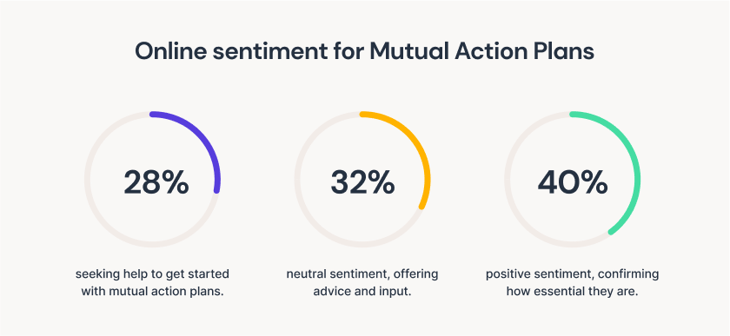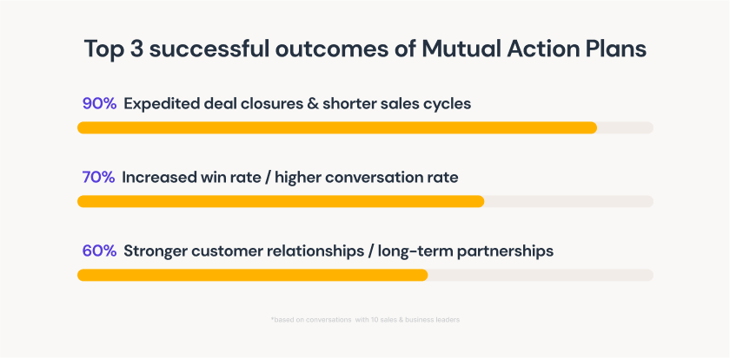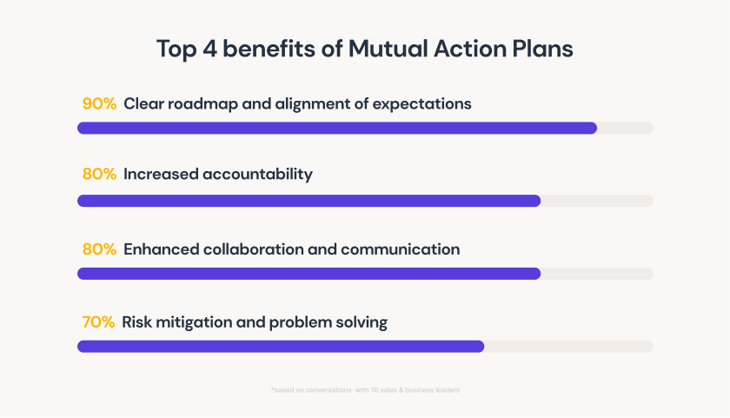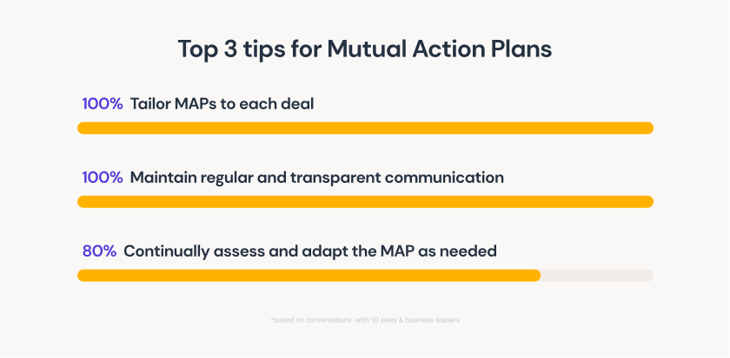The B2B sales industry is worth an estimated $16 trillion a year in the US alone.
It’s clearly big business, but the bigger the deal size, the more complex the sale.
With this in mind, McKinsey found that 66% of B2B buyers still prefer either traditional in-person sales interaction or remote human interaction versus digital self-serve options.
This means that in order to capitalize on the B2B market, you need to equip your sales team with the right tools to communicate effectively and work on deals – which, in many cases, can take 6-18 months to close.
CRMs are ubiquitous with B2B sales at this stage, so as a revenue leader, you’ll need to dig a little deeper to find the unfair advantage that puts your team ahead of the rest.
So, where do you find an advantage?
At GetAccept, we’ve got you covered:
Introducing the Mutual Action Plan (MAP).
New to mutual action plans?
Many revenue leaders are.
In this article, we explain what a mutual action plan is and how it can benefit you. We will also share use cases and best practice tips - and not just tips from the GetAccept team but from revenue leaders at high-growth companies in the sales community.
Ready to learn more?
Click the links on the left to jump to specific sections, or scroll below to see how we used AI, sales communities, and interviews with revenue leaders to collect unique insights into how organizations are using MAPs today.
About the research
Data presented in this article is based on input from sales and business leaders, interviews, and online communities that have been analyzed to help provide you with unique research from organizations using mutual action plans to drive growth from their B2B sales process.
One of the first things we did was analyze more than 100 posts and threads on mutual action plans (MAPs) across three sales-focused online communities.
Here’s what we found:
40% of the comments talked positively about how they’re using MAPs and how essential they are to the way they close B2B deals, while 60% had either never used them or were not using them to their full effect.

This is where your opportunity lies.
To move you and your sales team out of the 60% of teams that don’t use MAPs and into the 40% of sales performers leveraging mutual action plans to drive growth in B2B sales.
Let’s go!
What is a mutual action plan?
A mutual action plan (MAP) is a shared document that aligns sales reps and B2B buyers that includes details on who is involved (stakeholders), the purpose of the deal (objective) and what's required to complete the deal (milestones).

“Mutual Action Plans allow salespeople and clients to directly shape and control the deal's outcome. Through this, both parties become active participants and can freely contribute their perspectives. This shared ownership instills a greater commitment and dedication to the deal's success.” - Normand Chevrette, President & CEO, CME CORP.
In its most simple form, a mutual action plan is a document sent by email or a shared spreadsheet. But the most sophisticated and successful sales organizations use specialist digital sales room software to power their MAPs.
Why are mutual action plans important?

“Mutual Action Plans help me to be sure I am aligned WITH the customer on what I will do for them and what work they are doing to get a deal across the line.” - Heather Leo, Account Executive, Chili Piper
Mutual action plans serve a specific purpose in the sales cycle – to keep everyone moving in the same direction toward closing a deal. They offer a convenient and transparent way to organize communication, outline actions, and monitor progress.
It gets better.
We spoke with 10 B2B sales and business leaders from a variety of sectors that can benefit from MAPs, including SaaS, Recruitment, and Manufacturing, to understand the general consensus on what makes mutual action plans so important.
The top 3 successful outcomes you can expect from using a mutual action plan are expedited deal closures and shorter sales cycles, increased win rate / higher conversion rate, and stronger customer relationships / ongoing partnerships.

Let’s take a closer look at each one.
Expedited deal closures and shorter sales cycles
Depending on the product you sell and the types of organizations you’re selling to, it’s possible that some sales cycles take between 6 and 18 months to close.
Any tactic that can be implemented to shorten the time between initial contact and the signed contract would be a huge win for your organization.
One of the leaders we spoke to was Abhishek Shah from Testlify, who said in his business, MAPs have helped him and his team capitalize on opportunities more efficiently:

“MAPs have helped us streamline the deal closure process, resulting in shorter sales cycles. By breaking down complex deals into actionable steps and closely monitoring progress, we've been able to reduce the time required to close deals, enabling us to capitalize on opportunities more efficiently.” - Abhishek Shah, Founder, Testlify
Increased win rate / higher conversion rate
By utilizing mutual action plans effectively, not only will you reduce the time it takes to close a sale, but you’ll have a highly effective tool to help you close even more deals than before.

Mutual Action Plans changed my closing process and win rates for the better. As soon as we become a preferred supplier, I find what is driving the sale and the deadline for it, I then work the actions back to ensure I can hit the date and close.” - Sean Mackay, Senior SaaS Enterprise AE, FTSE 50 Company
Stronger customer relationships / ongoing partnerships
Once you’ve made the sale by closing the deal, that’s not the end of the matter:
You want your customer to stick with you in the long term as well.
This is where MAPs can help, too. By setting the tone of the relationship from the outset and demonstrating value early, it enables you to quickly establish trust and build a mutually beneficial partnership with your customers.

“A MAP helps clarify the expectations and roles of both parties, demonstrating that both the buyer and the seller are committed to achieving the desired outcome. This encourages stronger relationships and trust.” - Will Yang, Head of Growth & Customer Success at Instrumentl
In addition to these three key outcomes, there are also a number of unique benefits that mutual action plans can provide B2B sales organizations.
What are the benefits of using mutual action plans?
MAPs aren’t just a way to shorten sales cycles, increase win rates and build relationships with customers. In conversations with sales and business leaders, we also uncovered seven other benefits of mutual action plans that you should consider.

1. Clear roadmap. Having a clear roadmap of actions and milestones allows you to set expectations with the customer from the outset. There are no surprises, and everyone is aligned and moving in the same direction from the outset.
2. Increased accountability. Having all the information shared centrally means that nothing can get lost in email chains, promises you make on calls don’t go unrecorded, and all actions, milestones, and responsibilities are clearly mapped out.
3. Enhanced collaboration and communication. A MAP allows you to not only list all the stakeholders you need to work with and identify champions but also helps you get access to them through the enhanced communication and organization benefits that come from successful leverage of a mutual action plan.
4. Risk mitigation. Driving your sales process with a mutual action plan allows you to identify risks early and develop ways to work around those risks to stop deals from stalling.
5. Buyer confidence. Using a MAP gives your buyer confidence in you, your sales process, and your organization. It’s a clear indicator that you mean business, and you know what you’re doing.
6. Clearer pipeline forecasting. Having a clear, repeatable, and trackable process for closing deals gives you unparalleled levels of information that you can use to improve your pipeline forecasts.

“Mutual action plans help provide a better buyer experience because it holds not only me accountable but the buyer as well in order to achieve the end goal. A mutual action plan makes it feel as though you and the buyer are working together as a team to get something done instead of having to "chase" next steps.” - Marykate Hegarty, Commercial Account Executive, Seismic
7. Enhanced experience. Using a mutual action plan allows you to enhance the buyer experience. Not only does it promote confidence in you and your organization, but it also helps you to stand out against your competitors who aren’t using MAPs in their sales process.
How to create a mutual action plan

“I recall a particular instance where we implemented a MAP with a key client. By working closely together to develop the plan, we identified potential roadblocks, mitigated risks, and aligned our strategies. The result was a streamlined sales process, accelerated decision-making, and a significant increase in the likelihood of closing the deal successfully. The MAP was a guiding document, keeping both parties focused and accountable throughout the journey.” - Derrick Hathaway, Sales Director, VEM Medical
Mutual action plans can be adapted to suit the needs of your company and your customers, but if you want to make your own, there are five key components you’re going to want to include to ensure your MAPs succeed: initial details, objectives, stakeholders, milestones, and resources.
1. Initial details – this can include the names of your sales lead, the customer champion, the customer’s company, and the desired go-live date. It gives you all the basic information you need to kickstart the process.
2. Objectives – this is about capturing the customer’s current challenges, their desired outcome from working with you, and any specific requirements they may have that need to be met as a result.
3. Stakeholders – here you should list all the main players involved in the deal from both parties. This can often include senior leadership or C-Suite executives or other key sponsors and decision-makers, as well as those involved from a more operational perspective.
4. Milestones – there are several steps you and your customer will need to go through to close out the deal. Each step or milestone should have an owner, participants, due date, status, and actions listed. Classic milestones in a MAP include discovery call, demo, POC, proposal, contract negotiation, security, and compliance, finalizing contracts, and going live.
5. Resources – list or include any additional resources, documents, or information you’re going to need to make the sale and close the deal.
Mutual action plan use cases
Mutual action plans are highly flexible and can be adapted to a number of different scenarios, deal sizes, and outcomes.
Here are three key use cases to get you started.
Use case 1: Large B2B / enterprise sales
If your ideal customers are enterprise contracts that are worth 6 or 7 figures, then you’re going to use every tool you’ve got to close the deal.
Mutual action plans are the perfect tool for enterprise deals, they keep all stakeholders in the loop at all times and clear on the next steps at every turn. Without one, you’d struggle to close a deal of that size!

“I was able to close a deal with a large enterprise customer that was worth over $1 million. The deal was complex. By using a MAP, we were able to clearly define the roles and responsibilities of each party, which helped to ensure a smooth and successful implementation.” - Gaurav Nagani, CEO, Desku Inc
Use case 2: Smaller deals, but higher control needed
Because they’re flexible and adaptable, MAPs aren’t just good for closing enterprise deals. In fact, they can be a reassuring presence to help get smaller deals over the line as well.
There are often times when the deal size may be modest, but the strategic importance of closing the deal can’t go unrecognized. When you need that higher level of control on a deal, use a mutual action plan to put the deal in place.

“I was also able to close a deal with a small business customer that was worth just $10,000. However, this deal was still important to the customer, and they were very grateful for our help. By using a MAP, we were able to clearly define the steps needed to implement our solution, which helped to ensure that the customer was successful.” - Gaurav Nagani, CEO, Desku Inc
Use case 3: Across the customer journey
The journey doesn’t end for your customer once the contract is signed with you.
There is implementation, support, training, service delivery, and a whole host of additional milestones with you for them to worry about. Anxiety over these events can put the sale in jeopardy, so one way to mitigate this is to include them in your MAP to protect you against the risk of the deal collapsing.

“We had a prospective client who was hesitant to commit to a deal over concerns about onboarding and training their remote team for our software. We developed a MAP that included detailed plans regarding support, training, and a timeline to make the transition seamless. Through this process, the client felt more supported, which ultimately resulted in closing the deal.” - Diana Stepanova, Operations Director, Monitask
Best practice tips for mutual action plans
Based on our discussions with sales and leaders, we found three best practice tips that apply to all revenue leaders looking to get started with MAP.

1. Tailor MAPs to individual customers
Make sure that you tailor mutual action plans to each individual customer as you work with them. It’s OK to use a mutual action plan template as a starting point, but there isn’t a one-size fits all approach to this.
Each customer will have a different set of objectives, stakeholders to manage, deadlines to reach, and expectations to hit – so make sure you plan accordingly.
2. Maintain regular communication
Mutual action plans bring everyone together on the same page, at the same time, all driving towards a common goal.
But as wonderful as they are, they are not a substitute for talking to your customers, updating them on what you’re doing for them, and establishing ongoing dialogue as part of your burgeoning relationship.
3. Continuous improvement and assessment
It’s important to note that a mutual action plan isn’t a ‘one-and-done’ task.
It needs to live and breathe as part of the sales cycle. This means you should be reviewing it regularly to assess where you might need to make changes or improvements.
This will help you not only close the deal but also ensure your processes are running as smoothly as possible – helping you close more deals in the future.
Conclusion
Mutual action plans are very much a secret weapon that you can leverage to dramatically transform your performance in B2B sales – particularly for larger deal sizes or more complicated deals.
They give you and your customer a clear indicator as to what to expect at each part of the process, the role each party will play in the deal, and the actions required to move forward together in alignment.
Ready to use mutual action plans to close more deals?
Sign up for a free trial or book a demo with one of our sales experts.
Mutual action plan FAQ
What is the typical deal size to use a mutual action plan with?
It depends. A lot of companies have a hard and fast rule of rolling out mutual action plans for all deals bigger than $30,000. Other companies will only use them for true enterprise sales ($100k+). It’s also been known to use MAPs on much smaller deals of strategic importance.
Can I edit a mutual action plan?
Yes! In fact, if you want your mutual action plan to be successful, you should be constantly editing and updating it. This is because goalposts move and things change, so you’ll need to keep it fresh to reflect the latest status between you and your customer.
Do you have an example of a mutual action plan?
Yes! When you create a free trial, you’ll have access to our very own Mutual Action Plan feature. Try it, and let us know your feedback.




